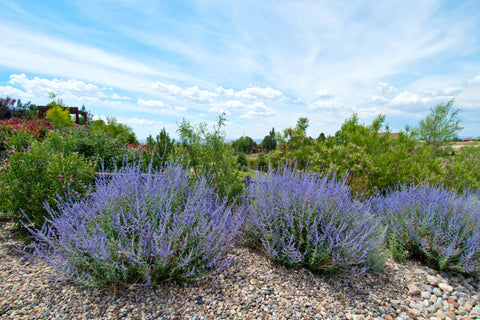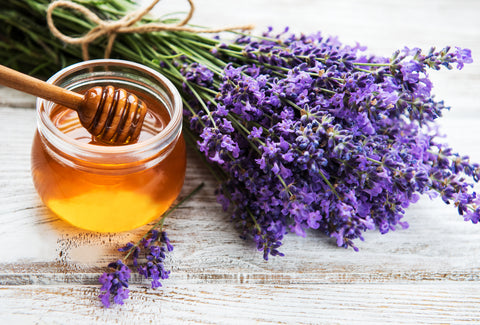Their fragrance travels with the breeze—Russian sage and lavender are often smelled before they're seen. Both are known for their distinct scents and alluring flowers, and both make excellent additions to a garden. However, you may be wondering which is better for you: Russian sage or lavender?
The variety you choose will depend on a few factors, so we've consulted with our plant experts to help you decide whether to plant lavender or Russian sage.
(Psst! Only have a minute to read? Click here to jump to our Lavender vs. Russian Sage Snapshot!)
Lavender vs. Russian Sage: Similarities & Differences
Both are low maintenance and tough…
Russian sage and lavender are easy to care for. Each plant flourishes when placed in locations with well-drained soil and full sun. Once established, neither needs frequent maintenance.

…But Russian sage can handle more water (and lavender thrives in poor soil)
Lavender can’t stand much water. Russian sage, however, can grow in dry-to-medium soil. And while both plants can deal with less-than-ideal soil conditions, for lavender, the poorer the quality of the soil (even sand), the better. Don't waste your nutrient-rich compost on it!
Both can be used in foods, drinks, and perfumes…
That’s right—you can safely eat both Russian sage and lavender! It may seem a bit odd to chow down on an aromatic plant, but both are edible. Some people even batter and deep-fry these fragrant flowers. Lavender tastes great in desserts, while Russian sage is often added to more savory dishes.
Both Russian sage and lavender can also be ingredients for making perfumes, candles, essential oils, and more. They both have leaves filled with oil that, when rubbed together or broken, releases a pleasant scent. And while you can find countless products on the market that include lavender and sage, it’s both easier and more cost-effective to simply grow your own.
Some boil Russian sage to create a tea to aid an upset stomach. Lavender (even just the smell of it) has been known to help relieve stress and bring on sleep. However, it’s important to always ask your doctor before using any herb for medicinal purposes.

…But lavender is the choice for unique sweets
As we mentioned before, lavender buds can be used in pastries and other desserts. Its aroma and flavor are sweeter than that of the Russian sage, which has a more earthy, herbaceous taste. It’s also a more distinct flavor, whereas Russian sage may not be as detectable in dishes.
Both bloom purple in the summertime…
Lavender and Russian sage will deliver plentiful drifts of violet color, and they’re the ideal accent plant for nearly every sunny landscape. They both add color and texture, and each one can fit a variety of styles, from cottage and Mediterranean gardens to contemporary and desert aesthetics.

…But the Russian sage’s spiky blossoms last the longest
These long-flowering perennials bloom from mid-summer through early fall. Their vivid purple-blue blooms will give you incredible fragrance and abundant foliage for months on end. Their flowers also differ from lavender because they’re spiked and grow further down the stalk.
Which Plant Should You Choose?
With each plant offering a long list of benefits, it may be hard to decide which one is the right fit. You can’t go wrong with either Lavender or Russian sage, as both will provide stunning, easy-to-care-for accents in gardens, along pathways, or when arranged as rows of hedges.
For Wetter, More Dynamic Climates: Russian Sage
If you live in a climate with frequent temperature changes and more moisture, Russian sage plants may be the best choice. The striking, sturdy foliage will usher in early spring with plenty of vibrant color and visits from pollinators. Below, we’ve summarized a few types of Russian sage you may consider:
Russian Sage
A vigorous grower, the original Russian sage is both resilient and beautiful. Watch it spread effortlessly in zones 4 through 9 outdoors, all while its clusters of sturdy blooms enchant spaces of any size.
Denim 'n Lace Russian Sage
Denim ‘n Lace thrives in zones 4 through 10 outdoors. Offering long-lasting color and quick growth, this plant is an inspired addition to any area.
Lacey Blue Russian Sage
The name sums up this distinct variety of Russian sage. Every summer, it will deliver intricate and colorful sprays of flowers that last. The Lacey Blue does best outdoors in zones 4 through 10, requiring minimal maintenance and upkeep.
For Hot, Dry Climates and Poor Soil: Lavender
If you live in drier, warmer areas, consider planting lavender. Even through drought or in the desert sand, these exquisite plants will add ample color and dimension. Furthermore, they flourish in even the poorest soil (so even if nothing else grows around you, lavender will!).
Phenomenal™ Lavender Plant
A best-selling plant, the Phenomenal Lavender lives up to its name. A remarkable bloomer that delivers stunning color, second to none. This variety performs best in outdoor growing zones 5 through 9, and it's the perfect start to your lavender collection.
Sensational™ Lavender Plant
This lavender variety is known for its fuller flowers and more compact growing style. The Sensational does well in zones 5 through 9 outdoors, and thrives in even the harshest sunlight.
Hidcote Purple Lavender Plant
The Hidcote Purple Lavender offers the flawless combination of brilliant color and sweet fragrance. This plant variety is most often found in outdoor zones 5 through 8, preferring not to live in extreme heat or cold.
Big Time Blue Lavender
Despite being low-maintenance and mesmerizing, the Big Time Blue can rarely be found in any garden stores. A hardier lavender variety, it grows in zones 5 through 9 outdoors and is ideal for mass planting, patio pots, as a flowering hedge or garden accent.
Lavender or Russian Sage: Which Is Better?
That’s an impossible question to answer! Both have their strengths and, to be honest, very few weaknesses. The best way to decide between Russian sage and lavender is to look at where you live:
- Is there a lot of moisture?
- How nutrient-rich is the soil?
- Do you experience all four seasons?
But no matter what you plant, both Russian sage and lavender will bring you fragrance, utility, and beauty every summer!
Lavender vs. Russian Sage Snapshot
|
Lavender |
Russian Sage |
|
|
Size (H x W) |
1-3 ft. x 1-3 ft. |
3-4 ft. x 3-4 ft. |
|
Growing Zones |
5-9 outdoors |
4-9 outdoors |
|
Flower Color |
Purple |
Purple |
|
Flower Shape |
Rounded, tubular |
Spiky, rounded, tubular |
|
Preferred Climate |
Hot, dry |
Temperate/hot, average/dry |
|
Culinary Profile |
Sweet, floral, fragrant |
Savory, robust, fragrant |

